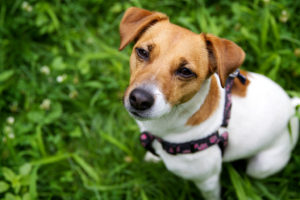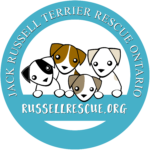
Signs of separation anxiety are only seen in the owner’s absence, or when the dog is prevented from being close to the owner. The dog is in a high state of anxiety because he wants to be with the owner and is prevented from doing so.
Dogs are social animals, and form strong attachments to other dogs and to people.
The dog’s first experience with separation anxiety is when the pup is separated from its mother and litter mates. New owners expect their puppy to be restless the first few nights he spends in his new home. In later life, problems arise when a dependent dog has a strong attachment to one person. The owners are kindly people who spend a lot of time with their dog; they allow it to follow them around the house, and appreciate the excited welcome the dog gives them when they return home. Unwanted behavior often starts when the owner’s schedule changes so that the dog is left alone more frequently, or at different times, than he is used to.
Signs of separation anxiety are only seen in the owner’s absence, or when the dog is prevented from being close to the owner (for example, at night). The dog is in a high state of anxiety, or conflict because he wants to be with the owner and is prevented from doing so. Dogs, like people, cannot stay in a high state of anxiety for long and must do something to reduce tension. While you or I might have a relaxing bath, go for a run, or have a drink, the dog can only do “doggy”‘ things to reduce tension.
Things Dogs do to Reduce Tension
- Chewing, digging or licking, which cause destruction in the home
- Hyperactivity (pacing)
- Reduced activity levels, depression, loss of appetite
- Urination or defecation
- Diarrhea, vomiting or constipation
- Aggression when the owner leaves (mouthing, growling, nipping)
It is important to realize that the dog is not doing these things to get even with you for leaving him, out of boredom, or due to a lack of obedience. Consider instead that his dependence on you is so great that he becomes anxious when you leave. He must relieve his tension, and his methods of doing so may cause considerable damage. Also consider that, no matter how flattering his constant attention to you may seem, it is not fair to the dog to allow him to be so stressed by your absence that he must respond with one of these unwanted behaviors.
Treatment of Separation Anxiety
What Doesn’t Work
1. Many people wonder about getting a pet for their pet so the dog won’t be lonely while they are out. This does not work, because the excessively tight bonding is between you and your dog, not between another animal and your dog. Having company has no effect on the distress your dog feels when you leave.
2. Punishment does not work. Dogs do not make the association between making a mess and being punished for it at a later time. They also cannot reason that if they don’t make a mess in the future, they won’t be punished. Even though your dog may look “guilty” when you come home to a mess, he has learned that when you are present and a mess exists, he is in trouble. If someone who had never scolded your dog went into your house, and a mess was present, the dog would not look guilty.
3. Tying the dog to chewed objects, or painting them with a hot sauce, may stop him from chewing them. However, the tension he feels will be redirected elsewhere.
What Does Work
1. Take the dog for a fast walk on a leash at least once a day. It should be 15 – 30 minutes long. Even if your dog has a large yard to run in all day, the fast walk will be beneficial.
2. Obedience train for 10 minutes twice daily. Train control and quiescence by teaching come, sit stay and down-stay. The goal is to achieve a 20-minute down-stay. Train for food rewards at the beginning, but later vary food, touch and voice praise. Give the dog a reward every time he performs when you are first teaching a command, but as he gets better at it, reward the behavior intermittently. This makes the response less easily forgotten.
3. Give the dog an acceptable item to chew on, only when you go out. We find that a hard nylon bone is very useful. Drill a number of small holes in it, and stuff the holes with cheese. The cheese helps train attachment to the bone. Give the bone to the dog about 15 minutes before you go out, and before you give the dog any clues that you are about to leave.
4. Everyone in the family should totally ignore the dog for 15 – 20 minutes before leaving the house (after you give the dog his bone) and for at least 20 minutes on returning home. This helps to reduce the dog’s excitement level before you leave, which reduces the tension he feels when you are gone.
5. In addition to the above training, the person the dog is most attached to should totally ignore the dog for a minimum of 3 weeks. This is the most important part of the treatment, because it is what reduces the dog’s dependence on you. Ignoring means not allowing the dog to follow you around, and not looking at, talking to or touching the dog. Just pretend that the dog does not exist! I know how difficult this is (you got a dog in the first place to enjoy its company) but it is absolutely essential that you do it. Keep in mind that it is for a short time relative to the dog’s life, and that if you do this conscientiously, it will work quickly and effectively to solve your problem. Be assured that you will be able to relate to your dog in a more normal way once the dog’s dependence on you has been reduced.
6. Make a list of the things that you do before you go out for the day (and the destruction occurs), and the things you do before you go out for a short time (and no destruction occurs). Then, mix up the clues. For example, if the dog is fine when you go downstairs to do the laundry, try taking the laundry basket with you when you go out to work.
7. Drugs may be used in association with training, but they do not cure the problem. In fact, the use of medication reduces your dog’s ability to learn. Using drugs in conjunction with retraining may be necessary, but it will also prolong the treatment.
Reprinted with permission of the Jack Russell Terrier Club of America



